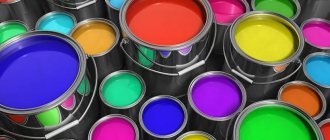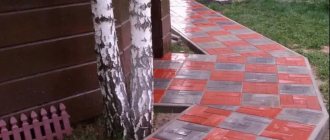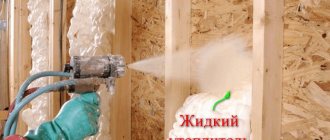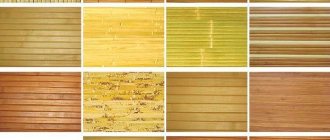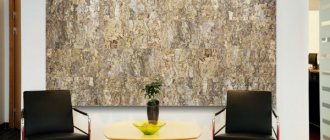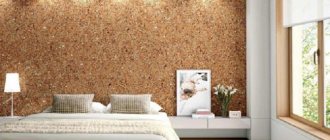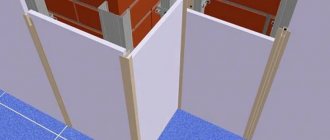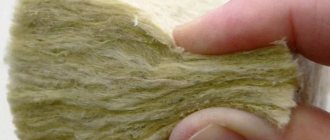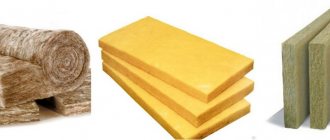For those who want to add some zest or a bit of originality to their interior, you can consider a simple room decoration option. What is it about? We're talking about pearlescent paint. Its peculiarity is that special pigments in the paint refract light, so at different angles and under different lighting the surface of walls or other surfaces will look different. This is an amazing visual effect. Velvety surfaces are considered noble and original. This paint is used to create unusual finishing options. It is used to treat the entire ceiling or wall, or some of its sections.
What is special about pearlescent paint for finishing? Why does it have such an effect? What surfaces can be painted with pearlescent paint? What do the treated surfaces look like? We will look at the answers to these questions in this article.
Why does the composition have a velvety effect?
If everything is clear with ordinary paint, since it contains a simple coloring pigment, then what explains the pearlescent effect of the composition? Its beautiful and unusual effect is obtained due to the presence of a special powder pigment in the composition. It is when rays of light hit it that they begin to crumple.
Good to know! Powder with reflective pigment must be diluted exclusively with water-based dyes. Most often these are acrylic compositions.
The degree of refraction of light rays directly depends on the amount of pigments contained in the dye. So it turns out that after applying the pearlescent composition, the walls have a velvety effect. It looks just great, as you can see in the photo.
How can pearlescent paint be produced?
If you are excited about the idea of using pearlescent paint in your decoration, then you need to understand what exactly to buy in the store. The thing is that construction stores can sell pearlescent pigment in a variety of forms. Let's look at them in more detail.
- In powder form. The good thing about this consistency or type of pigment is that to get a pearlescent composition, you just need to add it to your acrylic-based dye. As a result, you will get your own pearlescent paint of the desired color range. You can also adjust the degree of effect yourself by adding a lot or little pigment. The disadvantage is that without proper experience, you can dilute the components incorrectly and unevenly, and the paint will be lumpy.
- In the form of a paste. It is also very convenient; it can be mixed with acrylic enamel, creating a wide variety of color schemes. The finished paint is homogeneous and easier to use. The disadvantage is that, unlike powder, its service life is much shorter. Therefore, after purchasing it, it is recommended to use it quickly.
- The last type is ready-made pearlescent wall paint. It doesn't need to be created. It is enough to buy the composition and use it immediately. This is an ideal option for beginners who do not know how to mix ingredients correctly. You just need to open the paint and start working on the surfaces.
The advantages of acrylic compositions with pearlescent pigment are that after drying they become durable and have excellent resistance to environmental influences. Therefore, there is no need to additionally protect the surface of the walls. The paint is used as a final finish for the facade of a room, a means for creating patterns on fences, as well as for decorative finishing of walls and ceilings indoors.
There is one nuance that concerns pearlescent paint of some colors. For example, gold color is used exclusively for interior decoration. Why? Because it will fade quickly when exposed to ultraviolet rays. But as for silver pearlescent paint, it can be used anywhere. It has high strength and resistance to atmospheric influences.
Description of mother-of-pearl effect paint from San Marco
Wall decoration sets the overall tone of the composition of any interior. Decorative paints with a mother-of-pearl effect are able to convey the atmosphere that you need. Pearlescent paint for walls and ceilings contains mineral particles that give a crystalline sheen. By varying the application technique, you can achieve a variety of effects - wet silk, original decorative concrete and others. San Marco offers several options for this material, including:
- Perlaceo, which will create an atmosphere of luxury even in the most simple design. It has a translucent light structure. Available in twenty-four shades.
- Cavenier - has a paste-like consistency that is easily applied to various coatings, creating a mother-of-pearl effect. The silver base makes it possible to create a wide palette of colors: from white, beige to dark shades.
If you need to get a pronounced shine on the surface, metallic effect paint may be suitable.
What surfaces can be painted
Another advantage of the pearl composition is that it is universal and suitable for a wide variety of surfaces. More precisely, it can be used to paint the following surfaces:
- tree;
- glass;
- concrete;
- drywall;
- Chipboard and similar lumber.
It turns out that there are practically no places in the house that cannot be treated with it, with the exception of plastic surfaces. If we talk about the qualities and characteristics of the composition, they are the same as those of acrylic enamel. Quite often, components can be added to water-based acrylic compositions, which provide additional protective effects. For example, paints for metal have anti-corrosion properties, and compositions for wood prevent rotting and the development of fungus. But these additives do not affect the decorative qualities. But with them the surface will be protected and will last longer.
Decoration methods
Speaking of creating paint by adding powder pigment or pigment in the form of a paste, depending on the consistency, you can get a variety of effects after applying the composition. In general, there are two design options.
The first of these is a strong concentration, in which the pigment is added in large quantities. In this case, they do not pay attention to the future color, since it is secondary. The main task is to create a shiny mother-of-pearl surface with the desired shade. Most often, these dyes are rarely used to paint an entire room. The thing is that walls and ceilings can press and tire due to their light refractive effect. Such a room cannot be called cozy.
Therefore, such pearlescent paints with a high pigment content are used to decorate a separate element of the interior. You can make such paint yourself, or you can buy it ready-made. If you do it yourself, you can achieve the concentration needed to implement a design idea.
The second decoration option is weak concentration. In this case, the emphasis is placed specifically on the color component, and the application process itself is no different from applying conventional paint. After treatment, the surface (wall or ceiling) will softly shimmer at different angles and under different lighting conditions. A light and cozy atmosphere is created.
Benefits and application methods
Among the advantages of decorative materials from San Marco, which have good reviews, it is worth noting:
- versatility;
- environmental friendliness;
- high adhesion;
- durability.
Preparing the surface for painting is carried out as standard: the wall is leveled, cleaned of dirt and dust, degreased, and primed. The following application tools can be used: brush, roller, sponge, spray gun. The material is applied to plastered screeds, to base surfaces (brickwork, wood, concrete), to plastic cladding and wallpaper for painting in apartments and other premises.
The best offers in the Sanmarco Vernici online store
The Sanmarco Vernici online store has the best deals on Italian San Marco products; here you can always buy inexpensive paint with a mother-of-pearl effect. Other popular types, including wall paint with a sand effect, popular decorative paint with a silk effect, textured and Venetian plasters, and wall paint with a velvet effect are also presented in the store. A convenient search system on the website and a catalog of decorative plasters with descriptions and current prices will help you choose the right option. Our managers will provide professional advice on the characteristics of a specific material. You can place an order directly in the salon, on the website or by calling us by phone.
Russia, Moscow, Moscow region, 109052
«>
How to apply pearlescent paint
It is noteworthy that the painting process is practically no different from conventional acrylic compositions. In this case, you can work with the same tools as in the first case. What is used to apply pearlescent paint?
Using a brush
It is ideal when you need to treat hard-to-reach places and a small area. It is used for painting corners, hard-to-reach areas, places behind radiators, etc. As for the entire surface of the wall or ceiling, its use is not recommended. The thing is that this will take more time, the consumption of pearlescent paint will be greater, and the quality of application will be lower. Possible leaks.
Using a sponge and spatula
It is used when it is necessary to achieve unusual patterns on the wall. She creates a beautiful drawing that is difficult to convey with a brush. This is an additional tool that is used when decorating the surface. The same goes for using a spatula. With its help, you can create an original pattern on the surface.
Using a roller
This is an excellent option for applying pearlescent paint, as it is convenient to process large surfaces, the composition is distributed evenly and economically. It is recommended to use a fur roller with short, fine pile. And in the case when you need to treat part of the wall or ceiling, it is recommended to protect the remaining surfaces with masking tape. It will help to make clear boundaries and not spoil the pattern. After painting, it is easily removed from the surface.
Using a spray gun
This is one of the best ways to apply paint. The layer is perfect, the work is completed quickly, and the consumption is economical. But before using pearlescent paint in a spray gun, it needs to be diluted to a certain fluidity. However, it is recommended to apply the paint using the method listed above. But the question arises, how exactly to do this? Let's look at this issue.
Matte or glossy - which is better?
There are many materials available for unique wall or ceiling designs. They differ in that some materials have a matte sheen, others have a glossy sheen. The choice of paint determines whether imperfections will be visible, whether you will feel comfortable in the room, and whether the chosen paint will not cause harm. Let's look at the main types of paints:
- Glossy. Such materials can please you with their strength and durability. The disadvantages of the coating include the fact that the surface should be prepared as best as possible before application. Please note that imperfections will not be hidden, but will be even more visible. Also, glossy paints are organically soluble. In other words, it is a toxic material, so it is not the best choice for interior work.
- Semi-gloss. They have a moderate shine and are suitable for rooms with high humidity, for example, kitchens, bathrooms or baths.
- Matte. Ideal for rooms with uneven surfaces, as it masks them well. One of the disadvantages is that often these types of paints are vulnerable to water and moisture. Therefore, they are not suitable for the kitchen, bath or children's room.
- Semi-matte. They differ from matte ones by a slight shine.
- Matte with a satin tint. Differs from matte in waterproof properties. Perfectly hides minor defects on the surface.
Stage 1 – surface preparation
Before applying the paint, there are some preparation steps you should take. Below are instructions for preparing surfaces:
- First you need to check the walls to see if they are damaged, if there are any defects and if there are any peeling areas left.
- If surface defects were identified during the inspection, they must be eliminated. How? The peeling plaster should be knocked down, and all protruding areas should be cleaned. Ideally, remove the old finish completely, putty the surface and bring it to perfection.
- After which the wall or ceiling is cleaned of dust and primed with the appropriate composition.
- When the primer has dried, you can begin painting. Only if you need to treat only part of the wall with pearlescent paint, then masking tape is glued to the surface. In addition, baguettes or other decorative elements also need protection.
There is one nuance that concerns the application of primer. It is important to carefully treat the surface without missing areas. There are no leaks in this work either.
Where is decorative paint with pearlescent effect used?
Decorative pearlescent paint can be used in the following options:
- Application to the base as an additional decorative element.
- Not just the formation of a layer of paint, but the creation of a relief, a certain texture.
- If you further process the mother-of-pearl coating, you can lighten or enhance dark colors.
Mother-of-pearl paint is applied to a primer suitable for it, the drying of which is necessary before painting with the chosen device. The ideal effect is obtained if the painting is done in two layers.
Stage 2 – painting with pearlescent composition
The further process is carried out according to this principle:
- Take the paint. If necessary, the pearl composition is tinted. The paint is mixed until smooth. Here you can dilute the paint and varnish material with water, no more than 10-15% of the total mass. Everything is thoroughly mixed.
- Using a narrow brush, apply a starting line under the baguettes. Its width is from 5 to 10 cm. It is needed for the convenience of subsequent application with a roller. In this case, the ceiling will not be dirty.
- After which the first layer is applied. This is the base or background. It is recommended to apply it with a velor roller. This is not difficult to do, it just requires patience and accuracy.
- Pearlescent paint is poured into a paint tray. Then you need to dip the roller into the bath and transfer the paint to the surface. It is important to do this evenly.
- After applying the base coat, you need to leave everything until completely dry.
To make the surface original, you need to apply a decorative layer. Appropriate paint is used. Its application will be done using a spatula. The paint is applied in strokes, like putty. As the second coat is applied, the surface will become silky. The effect is enhanced by the following layers. The movements are chaotic in order to create an original pattern on the surface.
Types of paints with silk effect
There are many types of decorative paints. Here are some of the bottom:
- Luminescent. This material is unique in that it glows in the dark. In addition, even after turning off the light, it glows for some time.
- Mosaic. Thanks to granulation, a strict and very beautiful interior of the house is created.
- Wet silk with pearlescent effect. Some people call paint a chameleon, because when you change the viewing angle or if you change the lighting angle, the color itself will change.
- Pearlescent with a metallic effect. Bronze, gold or silver tone finish.
Advantages of paint
We can confidently say that a room decorated with such decorative paint will have an excellent look that cannot be compared with wallpaper or an ordinary hard hat. The appearance of the room will be unique and rich. But besides this, there are some other advantages:
- environmental friendliness;
- resistance to ultraviolet rays, moisture, temperature changes;
- ease of maintenance;
- unique wall design;
- good adhesion, or, in other words, adhesion to the surface;
- ability to mask defects.
Painting process
It should be noted that the painting process is quite complex and labor-intensive, so you cannot do it without special skills.
To begin with, it is very important to prepare the surface well. It is important that nothing falls off the wall and that there is nothing superfluous. All unevenness must be smoothed out using putty.
The next step will be treating the wall using a special impregnation. This will strengthen the wall and allow the paint to apply evenly. Approximately six hours after impregnation, you can begin priming the walls. After complete drying, sand the surface again and completely level it.
The second step, after preparing the surface, will be the process of painting the walls. You can apply the paint with a spatula, roller, brush or spray gun. After painting, we apply a varnish coating or a special wax, thanks to which the walls acquire water-repellent properties.

